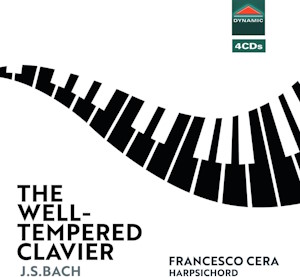
Johann Sebastian Bach (1685-1750)
The Well-Tempered Clavier Books 1 & II
Francesco Cera (harpsichord)
rec. 2021-2022, Palazzo Sanseverino, Laureana, Italy
Dynamic CDS7997.04 [4 CDs: 269]
Recordings of Bach’s Well-Tempered Clavier abound and many are reviewed in these pages, including several by myself. The two books, each of preludes and fugues in all 24 keys, major and minor, are widely considered to be the summit of keyboard music, the most-influential undertaking for solo keyboard of the Baroque era. They’re works I return to often, and have learned several of them myself over the years. Book 1 is dated 1722, and Book 11 followed some twenty years later. Though I love Bach’s monumental Well-Tempered Clavier, I have a slight preference for Book II. Technically more demanding than its predecessor, the composer travels down a more adventurous road with his harmonies. In addition, Book 11 encompasses a greater emotional range, revealing more fantasy and daring. It was a time when Bach was playing an active role in keyboard instrument development.
I found Cera’s artistry both engaging and persuasive, most particularly the way he addresses style and ornamentations. The latter are judicious, and at no time do they hinder the line of the music. These are deeply considered interpretations free of mannerisms and eccentricities. Overall, there’s a phenomenal display of musical imagination. Articulation is superb and the readings reveal an artist skilful in the delineation of voice parts. Tempi are well-chosen. There’s an agreeable palette of colours and timbres, which add greatly to the allure of the playing.
It’s worth picking out some of the highlights. Let’s start with Book 1. In the opening C major Prelude, well-known to most, the arpeggiated chord progressions have a modest simplicity and are expressively contoured. The C sharp minor Prelude has both nobility and an air of sad reflection. This elegiac quality infuses the E minor Prelude. There’s an inherent bleakness in the F minor and B flat minor Fugues. In fact, the latter sounds quite desolate in Cera’s hands. On the other side of the spectrum, the G major Prelude is uplifting and buoyant, whilst the A flat has a perky charm. The first part of the B flat Major Prelude has a madcap thrill, whilst the second half is more improvisatory.
Book 11 is a different ball game in many respects. It’s certainly more taxing on the keyboard player in terms of its greater length and formidable technical demands. Note the difference between the opening C major Preludes of both books. In Book 11 the opener is grandiose, announcing something on a more epic scale. Cera invests the F minor Prelude with an introspective quality, whilst the G minor has sufficient weight and gravitas, but not too heavy as some make it. The G major Prelude which precedes it has a lithe elegance to it. There’s a fine sunny aspect to the B flat major Prelude, with the Fugue delicately shaped and delineated.
Listeners will have their own preferences as to how they want to hear this music – on harpsichord or piano. I’m more partial to the latter if truth be told, but I’m very happy to listen to harpsichord versions if I like the sound of the instrument used. In this recording I’m very taken with the harpsichord Francesco Cera has chosen – a Daniele M. Giani 2019 (after Henri Hemsch 1736). The sound is weighty, resonant and is giving of a range of colourful sonorities, which Cera exploits to the full. The recording has the benefit of a generous and welcoming acoustic, which allows detail to register. All told, if you want a satisfying harpsichord version of these glorious works, this new release will offer rewards aplenty.
Stephen Greenbank
Help us financially by purchasing from





















